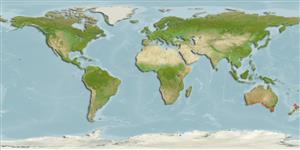>
Syngnathiformes (Pipefishes and seahorses) >
Syngnathidae (Pipefishes and seahorses) > Syngnathinae
Etymology: Stigmatopora: Greek, stigma = mark, signal + Greek, poros = porous (Ref. 45335).
More on author: Kaup.
Environment: milieu / climate zone / depth range / distribution range
Ekologi
laut; payau dasar (demersal); kisaran kedalaman 1 - 35 m (Ref. 31838). Subtropical; 32°S - 45°S
Indo-West Pacific: southern Australia and New Zealand.
Length at first maturity / Size / Weight / umur
Maturity: Lm 6.8, range 7 - 7 cm
Max length : 16.2 cm TL jantan/; (Ref. 5316)
deskripsi pendek
Morfologi | Morfometrik
Duri punggung (Keseluruhan (total)): 0; duri punggung lunak (Keseluruhan (total)): 35-47; Duri dubur 0; Sirip dubur lunak: 4. Body slender and snout elongate, continuous superior and inferior trunk and tail ridges, a dorsal fin which originates on trunk rings 5-9, and an extremely slender tail without a caudal fin. The trunk is broad in females and the brood pouch in males is on the underside of the tail immediately behind the anal fin. No caudal fin. Body rings: 16-19 + 67-79.
Occur in bays, estuaries and shallow coastal waters. Occurs among seagrass and algae (Ref. 31838). Occasionally found in floating seaweed (Ref. 31838). Ovoviviparous (Ref. 205). The male carries the eggs in a brood pouch which is found under the tail (Ref. 205). Males may be brooding at 6.5-7 cm TL.
Up to 41 eggs are incubated by the male in a brood pouch formed from laterally expanded flaps of skin on the underside of the tail. Newly emerged larvae may remain in the pouch (Ref. 31838).
Dawson, C.E., 1985. Indo-Pacific pipefishes (Red Sea to the Americas). The Gulf Coast Research Laboratory Ocean Springs, Mississippi, USA. (Ref. 5316)
Status IUCN Red List (Ref. 130435)
ancaman kepada manusia
Harmless
penggunaan manusia
informasi lanjut
AcuanBudidaya airprofil budidaya airStrainGenetikaElectrophoresesDiturunkanPenyakit-penyakitPengolahanNutrientsMass conversion
mitraGambarStamps, Coins Misc.Suara-suaraCiguateraKecepatanTipe renangArea insangOtolithsOtakPenglihatan / visi
Alat, peralatan
laporan khas
muat turun XML
Sumber internet
Estimates based on models
Preferred temperature (Ref.
123201): 13.9 - 20, mean 17.1 °C (based on 334 cells).
Phylogenetic diversity index (Ref.
82804): PD
50 = 0.5625 [Uniqueness, from 0.5 = low to 2.0 = high].
Bayesian length-weight: a=0.00389 (0.00180 - 0.00842), b=3.12 (2.94 - 3.30), in cm total length, based on all LWR estimates for this body shape (Ref.
93245).
Trophic level (Ref.
69278): 3.3 ±0.4 se; based on size and trophs of closest relatives
Daya lenting (Ref.
120179): Tinggi, Waktu penggandaan populasi minimum kurang dari 15 bulan (Preliminary K or Fecundity.).
Fishing Vulnerability (Ref.
59153): Low vulnerability (10 of 100).
